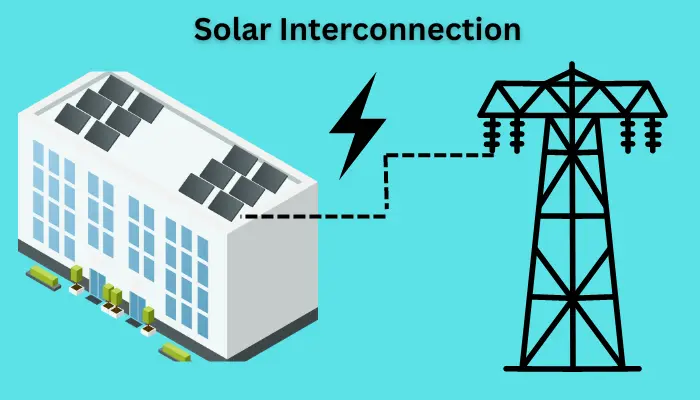What is Solar Interconnection and How Does it Work?
Installing solar panels on your roof to harness sustainable energy involves several essential steps. Among these, obtaining approval from the grid operator to connect your home to the electric grid is pivotal. The electric grid is the distribution system connecting power plants to homes and buildings, facilitating electricity supply.
This article aims to provide insights into solar interconnection, guiding you through the necessary steps before receiving approval from your local utility company and commercial solar provider to kickstart the power generation process from your solar system. Understanding solar interconnection is crucial for successfully navigating this aspect of solar panel installation.
What is Solar Interconnection?

Solar interconnection is a formal process through which a commercial solar customer seeks and obtains approval from their local utility provider to link to the electric grid. Your Solar Earth Inc. provider will manage this interconnection process on your behalf.
The duration of the interconnection procedure for residential solar can range from two to four weeks, depending on factors such as your utility company and the size of your system.
Connection costs are subject to variation, influenced by your utility, the scale of your solar installation, and the proximity of your home to the electric grid. Although the cost of this process is included in the overall system price, it can differ from one household to another. Understanding these nuances is key to comprehending the overall landscape of solar interconnection.
Solar Interconnection Application

Solar interconnection involves two primary processes, each with its distinct steps. Let’s delve into these processes:
1. Applying for Solar Interconnection:
The initial step is to apply for interconnection. Utility providers must verify your solar energy system’s compliance with essential electrical safety standards before permitting its connection to the grid. Additionally, they ensure adherence to their net metering requirements.
Information required for interconnection applications typically includes your historical electricity usage, property details, and specifics about the system you intend to install—such as size, equipment, design, production estimates, and system location.
The utility account holder can file interconnection applications, though many installation companies often handle this on behalf of the customer. If any red flags or missing information are identified, the utility may refuse grid connection, requiring modifications or resubmitting.
Upon approval from your energy utility, you and your installer can proceed with the installation process. The final step in solar interconnection is the “Permission to Operate” (PTO).
2. Permission to Operate (PTO):
PTO is the crucial stage where you obtain authorization to operate your commercial solar panel installation once it is installed on your property and has undergone inspection by local authorities.
The initial step of PTO involves a utility representative visiting your property to inspect the solar system. This inspection includes a review of the connection at the electrical panel, the system’s functionality, and an examination of the inverter.
Additionally, the utility may install a new meter or upgrade the existing one to monitor the solar electricity exports to the grid. This allows you to take advantage of the utility’s net metering incentives.
Following the inspection and meter adjustments, you will receive official PTO documentation authorizing you to officially activate your solar panel system for electricity generation. Understanding and successfully navigating these processes are integral to a seamless solar interconnection experience.
Types of Solar Interconnection
There are two primary grid-linking techniques in solar installations:
1. Line-Side Interconnections:
Line-side interconnections involve connecting the solar system to the utility side of your facility’s primary electrical panel or switchboard. This method allows for maximizing the potential array size, capable of meeting the energy requirements of the entire building. However, line-side interconnections often come with stricter regulations from utilities, and they may require equipment replacement, such as the Current Transformer (CT) cabinet.
2. Load-Side Interconnections:
Load-side interconnections are comparatively simpler to install, requiring the addition of a breaker at the end of the electrical panel, typically located where the switchgear or main electrical panel is situated. Despite their simplicity, there is a limitation on the array size due to the capacity constraints of the electrical panel or switchgear. It’s crucial to ensure that the combined current from the utility and the solar array does not exceed the panel rating.
Interconnection voltage is another critical design factor. Commercial premises usually receive 208V from utilities, while industrial buildings receive 480V. Inverters with an output of 20kW or more often produce 480V. Hence, a solar transformer may be necessary for commercial buildings to reduce 480V to the required interconnection voltage.
For larger solar arrays requiring more than one inverter, output wires must be combined into one using a combiner panel. Ideally located on the roof, the combiner panel may also need placement elsewhere, such as the facility’s electrical room.
Routing conductors from the roof to the interconnection point is a key step, with options including running leads along an exterior wall. However, aesthetics may be a concern for commercial buildings or apartment complexes. Ideally, a closet or other interior space can discreetly run leads out of sight.
During the early stages of the project design, Solar Earth conducts a comprehensive site study, assessing and recommending potential installation sites. The team also provides guidance on additional incidental hardware, such as over-current safety, minimizing its impact through strategic equipment positioning early in the design process. This proactive approach ensures a smooth solar interconnection process and minimizes the visual impact of necessary hardware.
Cost of Solar Interconnection
The costs associated with interconnection fees for residential solar panel systems can vary widely, ranging from zero to several hundred dollars, contingent upon the utility company, geographical location, and system size. It’s essential to be aware of potential interconnection fees when transitioning to solar, as some installation companies may include these costs in the overall pricing of your solar energy system.
In the case of small-scale residential solar installations, significant grid improvements for connections are seldom necessary. The electrical grid is designed to facilitate the flow of electricity from centralized power plants to homes and businesses. The grid seamlessly manages and accommodates the electricity generated by small-scale residential installations when fed back into the grid.
Conversely, larger commercial solar projects may require substantial grid upgrades. This is because commercial installations generate a higher volume of electricity, necessitating adjustments to the existing infrastructure to handle the increased electricity generation. The associated expenses for such upgrades can vary significantly based on the enhancements needed.
Fortunately, regulations in many regions safeguard solar customers from incurring additional charges until the utility company undertakes any necessary upgrades. This regulatory framework helps ensure a fair and transparent process for solar customers, allowing them to transition to solar energy without unexpected financial burdens related to grid enhancements. Understanding these dynamics is crucial for those considering solar adoption on both residential and commercial scales.
How Long Does It Take To Interconnect Solar Power?
The duration of connecting your solar panel system to the grid is influenced by factors such as your utility company and system size, similar to the impact on interconnection costs.
The interconnection application process in home solar panel installations generally spans two to three weeks. Following the installation and successful local inspection, obtaining permission to use the solar panel system typically takes one to two weeks.
The timeline for this process tends to be longer for larger commercial projects. This is because the application and assessment of grid infrastructure often require a more comprehensive review to ensure adherence to essential electrical safety standards. As a result, the interconnection procedure for significant commercial installations may extend beyond the time frame typically associated with residential projects.
Understanding these timelines is crucial for solar customers, allowing them to plan accordingly and have realistic expectations regarding integrating their solar panel systems with the grid. Clear communication with the utility company and solar installation provider can further streamline the process and provide a more accurate estimate based on the specific circumstances of each project.
Why is Solar Interconnection Important?
Public safety is paramount in solar interconnection procedures, demanding clear, well-defined protocols. Utility providers play a crucial role in safeguarding people, systems, and property by thoroughly examining each grid connection.
For public safety reasons, grid-connected solar power systems are designed to automatically shut down during power outages, preventing potential harm to utility personnel. In cases where solar power systems are equipped with battery storage, they are programmed to continue producing solar electricity during outages, storing the excess production in the battery instead of feeding it back into the grid. This protective mechanism is referred to as solar islanding.
During the interconnection procedure, the utility conducts checks to ensure that the required safety precautions for connecting your solar power system to the grid are in place and functioning effectively. Additionally, net metering on your electric bill is often established during this process.
It’s crucial to recognize that utility procedures and specifications may change. These updates can stem from various factors, such as the grid’s capacity to support additional renewable energy systems, modifications to regulations governing accepted solar equipment, adjustments to internal utility procedures, or changes to interconnection standards at the state level.
To navigate these evolving landscapes, your solar company must employ interconnection experts who are well-versed in the procedures and possess the expertise to manage solar interconnectivity processes. These preventive measures contribute to a secure and seamless connection process.
When linking your system to the power grid, obtaining approval for both your planned installation and the final installation is crucial for everyone’s safety. Employing a skilled solar provider becomes indispensable to ensure a smooth and secure connection process, even if it may entail a more extended procedure.
Solar Earth Inc Commercial Solar System
Linking your solar energy system to the utility grid is pivotal in solar installation. While selecting equipment, hiring an installer, and overseeing the installation process demand significant time and effort, solar interconnection offers the advantage of drawing additional energy from the grid whenever your commercial building requires more electricity than the solar panels generate.
If you’re eager to explore the possibilities of installing solar panels on your house, don’t hesitate to contact Solar Earth Inc. Contact us immediately to gain valuable insights into the process. Utilize our Free Solar Design Tool to kickstart your solar journey, discover potential savings, and visualize how solar panels might appear on your roof. Take the first step toward harnessing the benefits of solar energy for your commercial building by getting in touch with Solar Earth Inc. today.
Contact Our Friendly, Knowledgeable Staff
Solar Earth Inc., with expertise and certifications, empowers your home for enhanced energy generation. Contact us today to transform your home into a sustainable, long-term renewable energy source.
Get a free quote or Call at (805) 691-8000
